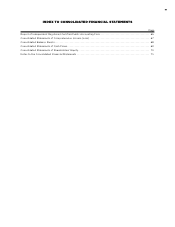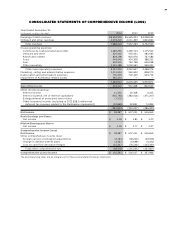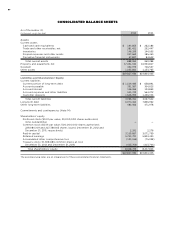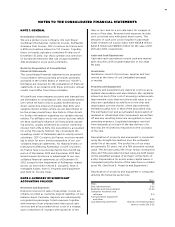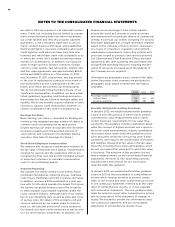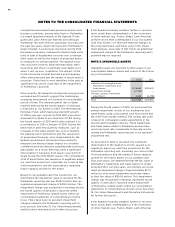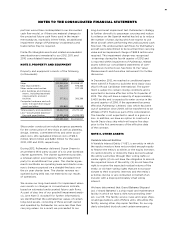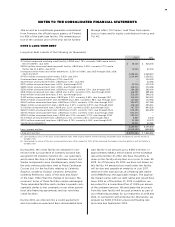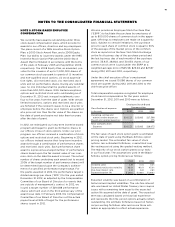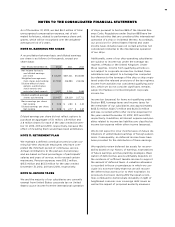Royal Caribbean Cruise Lines 2012 Annual Report Download - page 77
Download and view the complete annual report
Please find page 77 of the 2012 Royal Caribbean Cruise Lines annual report below. You can navigate through the pages in the report by either clicking on the pages listed below, or by using the keyword search tool below to find specific information within the annual report.
73
NOTES TO THE CONSOLIDATED FINANCIAL STATEMENTS
recoveries, if any. We accrue a liability when we
believe a loss is probable and the amount of loss can
be reasonably estimated. Due to the inherent uncer-
tainties related to the eventual outcome of litigation
and potential insurance recoveries, it is possible that
certain matters may be resolved for amounts materi-
ally different from any provisions or disclosures that
we have previously made.
Advertising Costs
Advertising costs are expensed as incurred except
those costs which result in tangible assets, such as
brochures, which are treated as prepaid expenses
and charged to expense as consumed. Advertising
costs consist of media advertising as well as brochure,
production and direct mail costs. Media advertising
was $200.9 million, $193.7 million and $166.0 million,
and brochure, production and direct mail costs were
$130.4 million, $124.3 million and $104.1 million for the
years 2012, 2011 and 2010, respectively.
Derivative Instruments
We enter into various forward, swap and option con-
tracts to manage our interest rate exposure and to
limit our exposure to fluctuations in foreign currency
exchange rates and fuel prices. These instruments are
recorded on the balance sheet at their fair value and
the vast majority are designated as hedges. We also
have non-derivative financial instruments designated
as hedges of our net investment in our foreign oper-
ations and investments. Although certain of our deriv-
ative financial instruments do not qualify or are not
accounted for under hedge accounting, we do not
hold or issue derivative financial instruments for trad-
ing or speculative purposes.
At inception of the hedge relationship, a derivative
instrument that hedges the exposure to changes in
the fair value of a firm commitment or a recognized
asset or liability is designated as a fair value hedge.
A derivative instrument that hedges a forecasted
transaction or the variability of cash flows related to
a recognized asset or liability is designated as a cash
flow hedge.
Changes in the fair value of derivatives that are desig-
nated as fair value hedges are offset against changes
in the fair value of the underlying hedged assets, lia-
bilities or firm commitments. Gains and losses on
derivatives that are designated as cash flow hedges
are recorded as a component of accumulated other
comprehensive (loss) income until the underlying
hedged transactions are recognized in earnings.
The foreign-currency transaction gain or loss of our
non-derivative financial instruments designated as
hedges of our net investment in foreign operations
and investments are recognized as a component of
accumulated other comprehensive (loss) income
along with the associated foreign currency translation
adjustment of the foreign operation.
On an ongoing basis, we assess whether derivatives
used in hedging transactions are “highly effective”
in offsetting changes in the fair value or cash flow of
hedged items. If it is determined that a derivative is
not highly effective as a hedge or hedge accounting
is discontinued, any change in fair value of the deriva-
tive since the last date at which it was determined
to be effective is recognized in earnings. In addition,
the ineffective portion of our highly effective hedges
is recognized in earnings immediately and reported
in other income (expense) in our consolidated state-
ments of comprehensive income (loss).
Cash flows from derivative instruments that are desig-
nated as fair value or cash flow hedges are classified in
the same category as the cash flows from the under-
lying hedged items. In the event that hedge account-
ing is discontinued, cash flows subsequent to the
date of discontinuance are classified within investing
activities. Cash flows from derivative instruments not
designated as hedging instruments are classified as
investing activities.
Foreign Currency Translations and Transactions
We translate assets and liabilities of our foreign
subsidiaries whose functional currency is the local
currency, at exchange rates in effect at the balance
sheet date. We translate revenues and expenses at
weighted-average exchange rates for the period.
Equity is translated at historical rates and the resulting
foreign currency translation adjustments are included
as a component of accumulated other comprehensive
(loss) income, which is reflected as a separate compo-
nent of shareholders’ equity. Exchange gains or losses
arising from the remeasurement of monetary assets
and liabilities denominated in a currency other than
the functional currency of the entity involved are
immediately included in our earnings, except for cer-
tain liabilities that have been designated to act as a
hedge of a net investment in a foreign operation or
investment. Exchange losses were $11.8 million, $1.6
million and $9.5 million for the years 2012, 2011 and
2010, respectively, and were recorded within other
income (expense). The majority of our transactions
are settled in United States dollars. Gains or losses
resulting from transactions denominated in other
currencies are recognized in income at each balance
sheet date.
Concentrations of Credit Risk
We monitor our credit risk associated with financial
and other institutions with which we conduct signifi-
cant business and, to minimize these risks, we select
counterparties with credit risks acceptable to us and




